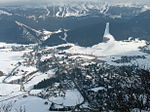The Gouffre Berger is a cave in the French alps within the commune of Engins high on the Vercors Plateau. It was discovered on 24 May 1953 by Joseph Berger, Georges Bouvet, Ruiz de Arcaute and Marc Jouffrey. From 1953 to 1963, it was regarded as the deepest cave in the world at −1,122 metres (−3,681 ft), relinquishing this title to the previous contender, Pierre Saint Martin, in 1964, after further exploration. The Gouffre Berger is now ranked 39th deepest cave in the world, and the 4th in France.
To return from the bottom of the cave back to the surface can take between 15 and 30 hours, without long breaks.
In 1967, Ken Pearce, a metallurgy lecturer from Britain, descended with the Pegasus Caving Club team from Nottingham UK, organised and led by Peter Watkinson, and along with a 40-metre (130 ft) dive, reached a depth of −1,133 metres (−3,717 ft). They emerged after 13 days underground, having set a new world record at the time. In 1968, B Leger and J Dubois reached a depth of −1,141 metres (−3,743 ft). This record was held until July 1982, when Patrick Penez attained −1,191 metres (−3,907 ft). In 1990, a breakthrough was made, connecting the cave to the nearby "Scialet de la Fromagère". This gives the current recorded depth as −1,271 metres (−4,170 ft)
In June 2011 the terminal sumps were dived and in 2014 another attempt was made to pass the sumps.
In recent years there have been six fatalities in this cave, five due to water. During a storm or heavy rain, the Gouffre Berger can become a dangerous trap and the water levels rise very quickly. In 1996, Englishwoman Nicola Perrin (née Dollimore) and Hungarian Istvan Torda died due to violent flooding in the cave.The water that flows through the cave has been traced to re-appear in the flooded sections of the Cuves de Sassenage.
As of 2017 the system was estimated to contain approximately thirty-seven kilometres of passage with eleven entrances.Since 2013, clean-up actions have been carried out by cavers. At the end of 2018 the gouffre Berger has become clean again.In 2014, attempts to join by siphons continued and an eleventh entrance, which communicates with the Fromagère, was created in September 2016; this is the "Delta 35 chasm"During the year 2022 a new network named "the Sardine Star", located at the level of the large waterfall of 27 metres, is being explored. ·










